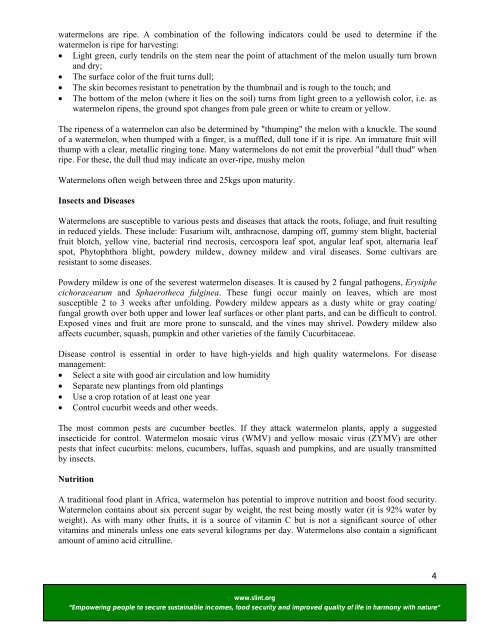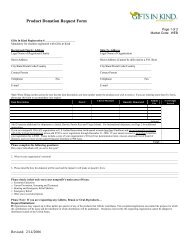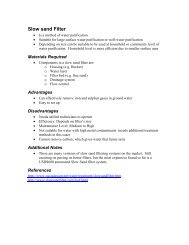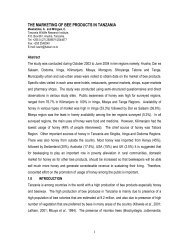FACT SHEET 1-Water Melon growing.pdf - Nabuur
FACT SHEET 1-Water Melon growing.pdf - Nabuur
FACT SHEET 1-Water Melon growing.pdf - Nabuur
Create successful ePaper yourself
Turn your PDF publications into a flip-book with our unique Google optimized e-Paper software.
watermelons are ripe. A combination of the following indicators could be used to determine if the<br />
watermelon is ripe for harvesting:<br />
• Light green, curly tendrils on the stem near the point of attachment of the melon usually turn brown<br />
and dry;<br />
• The surface color of the fruit turns dull;<br />
• The skin becomes resistant to penetration by the thumbnail and is rough to the touch; and<br />
• The bottom of the melon (where it lies on the soil) turns from light green to a yellowish color, i.e. as<br />
watermelon ripens, the ground spot changes from pale green or white to cream or yellow.<br />
The ripeness of a watermelon can also be determined by "thumping" the melon with a knuckle. The sound<br />
of a watermelon, when thumped with a finger, is a muffled, dull tone if it is ripe. An immature fruit will<br />
thump with a clear, metallic ringing tone. Many watermelons do not emit the proverbial "dull thud" when<br />
ripe. For these, the dull thud may indicate an over-ripe, mushy melon<br />
<strong>Water</strong>melons often weigh between three and 25kgs upon maturity.<br />
Insects and Diseases<br />
<strong>Water</strong>melons are susceptible to various pests and diseases that attack the roots, foliage, and fruit resulting<br />
in reduced yields. These include: Fusarium wilt, anthracnose, damping off, gummy stem blight, bacterial<br />
fruit blotch, yellow vine, bacterial rind necrosis, cercospora leaf spot, angular leaf spot, alternaria leaf<br />
spot, Phytophthora blight, powdery mildew, downey mildew and viral diseases. Some cultivars are<br />
resistant to some diseases.<br />
Powdery mildew is one of the severest watermelon diseases. It is caused by 2 fungal pathogens, Erysiphe<br />
cichoracearum and Sphaerotheca fulginea. These fungi occur mainly on leaves, which are most<br />
susceptible 2 to 3 weeks after unfolding. Powdery mildew appears as a dusty white or gray coating/<br />
fungal growth over both upper and lower leaf surfaces or other plant parts, and can be difficult to control.<br />
Exposed vines and fruit are more prone to sunscald, and the vines may shrivel. Powdery mildew also<br />
affects cucumber, squash, pumpkin and other varieties of the family Cucurbitaceae.<br />
Disease control is essential in order to have high-yields and high quality watermelons. For disease<br />
management:<br />
• Select a site with good air circulation and low humidity<br />
• Separate new plantings from old plantings<br />
• Use a crop rotation of at least one year<br />
• Control cucurbit weeds and other weeds.<br />
The most common pests are cucumber beetles. If they attack watermelon plants, apply a suggested<br />
insecticide for control. <strong>Water</strong>melon mosaic virus (WMV) and yellow mosaic virus (ZYMV) are other<br />
pests that infect cucurbits: melons, cucumbers, luffas, squash and pumpkins, and are usually transmitted<br />
by insects.<br />
Nutrition<br />
A traditional food plant in Africa, watermelon has potential to improve nutrition and boost food security.<br />
<strong>Water</strong>melon contains about six percent sugar by weight, the rest being mostly water (it is 92% water by<br />
weight). As with many other fruits, it is a source of vitamin C but is not a significant source of other<br />
vitamins and minerals unless one eats several kilograms per day. <strong>Water</strong>melons also contain a significant<br />
amount of amino acid citrulline.<br />
4<br />
www.slint.org<br />
“Empowering people to secure sustainable incomes, food security and improved quality of life in harmony with nature”
















